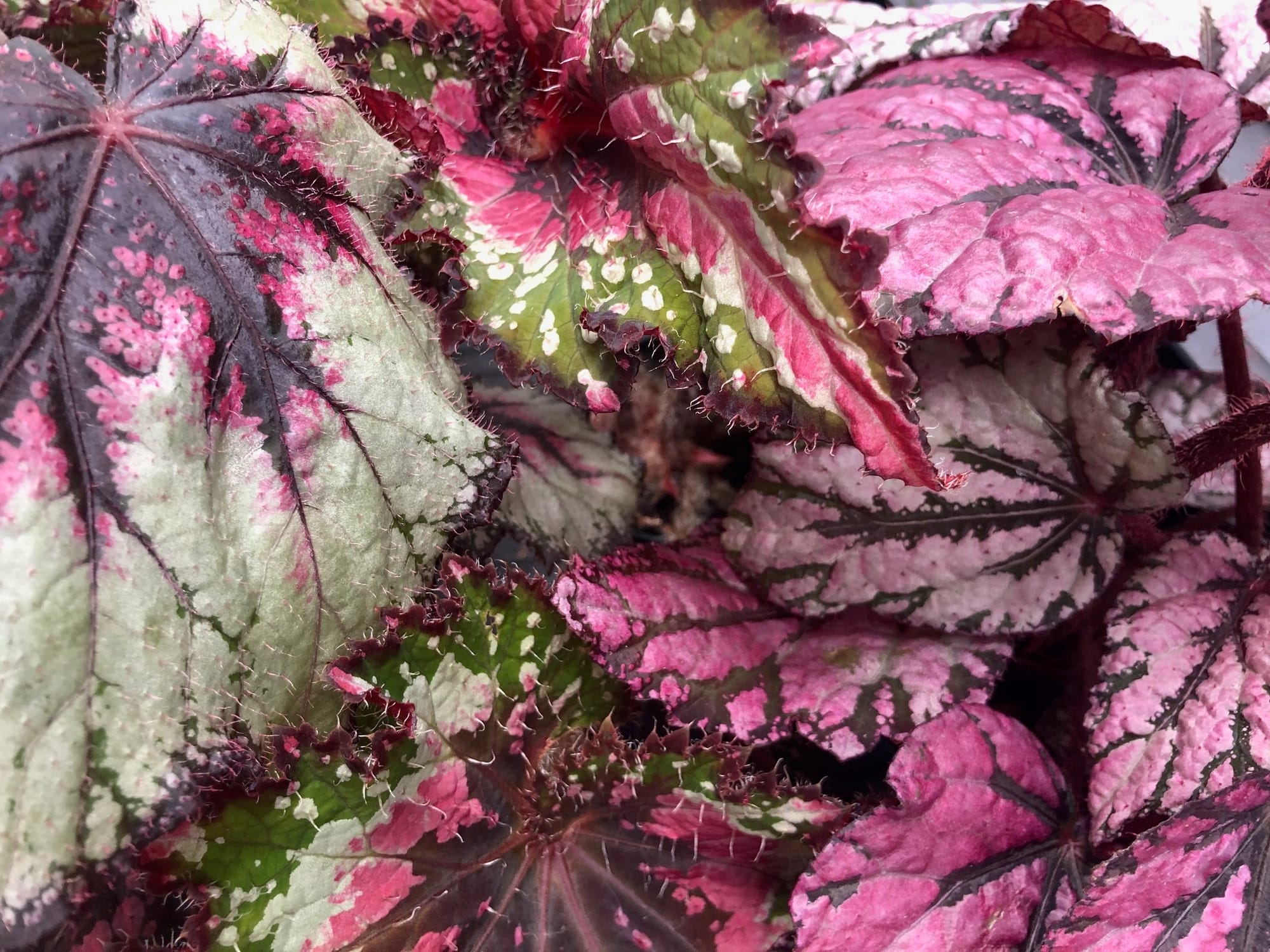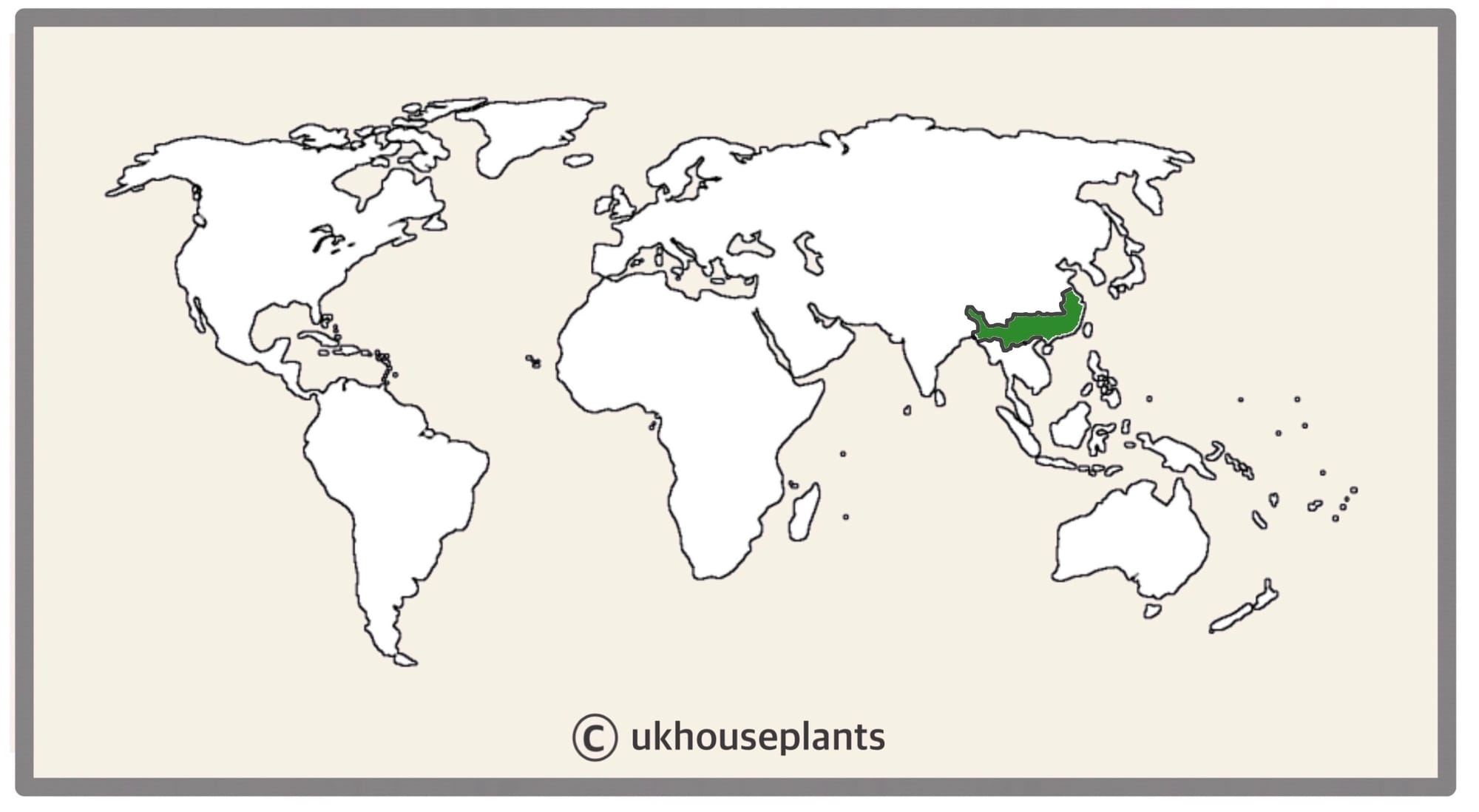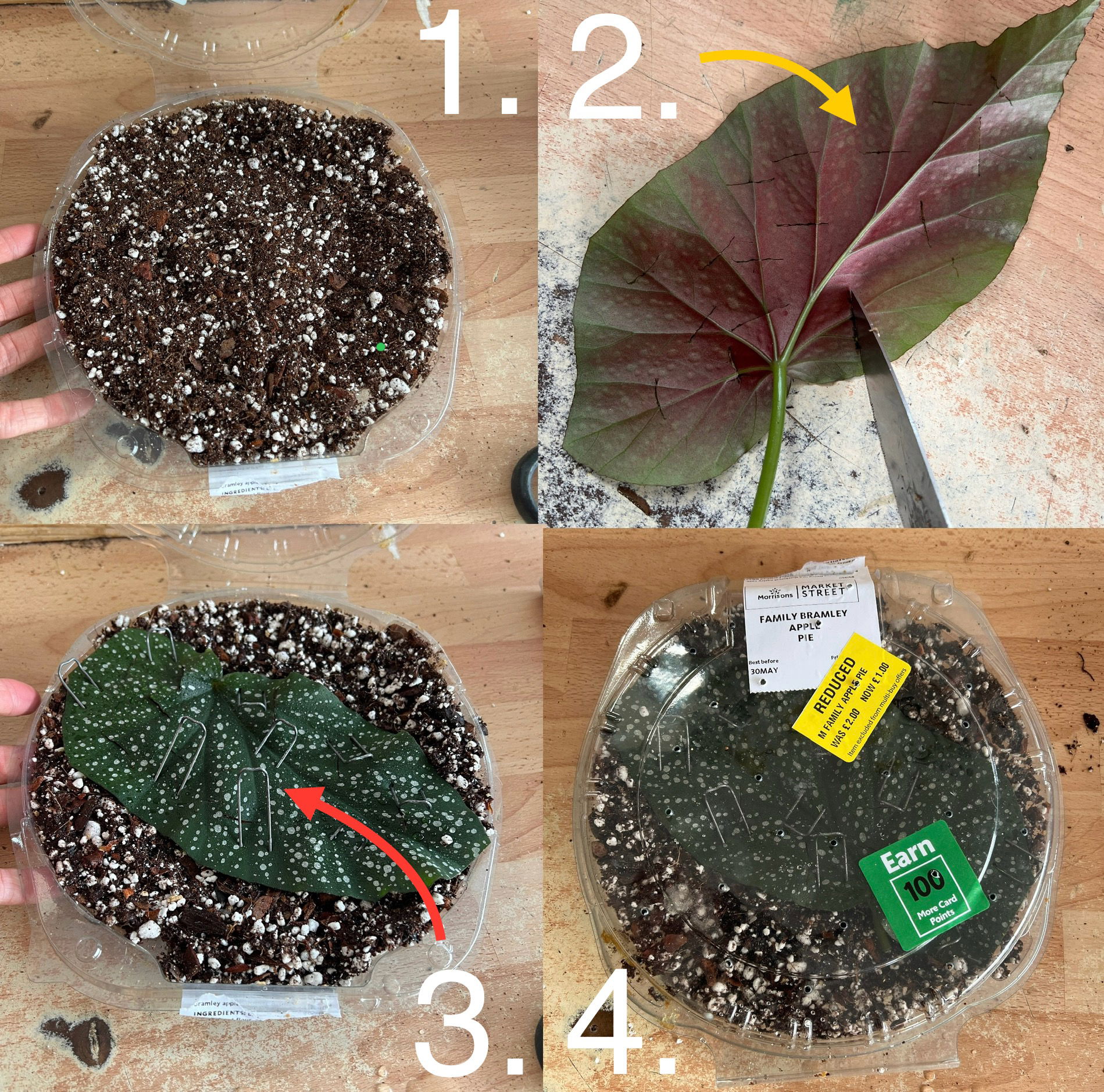
Begonia ssp.
Contents
- Top Tips
- Location, Water, Humidity & Fertilisation
- Common Issues
- Origins, Temperature, Propagation, Repotting & Toxicity.
Need the answer to a specific plant query? Book a 1-to-1 video call with THE HOUSEPLANT DOCTOR™, the website's friendly author, to overcome and address your niggling problem! Available on iMessage, WhatsApp, Facebook Messenger & more.
Top Tips & Info
- Care Difficulty - Moderate
- Provide a bright environment, avoiding prolonged exposure to the sun, especially in the spring and summer. A location that is too dark will cause the variegations (foliar patterns) to weaken, as well as an increased chance of rhizome rot.
- Keep the soil evenly moist, with slight periods of drying soil in between waters. Allow the top third to dry out, reducing this slightly further in the autumn and winter.
- Fertilise using a 'Houseplant' labelled feed every four waters in the spring and summer, reducing this to every six in the colder months.
- White flowers will readily flourish from the summer onwards that can last up to six weeks. Swap the 'Houseplant' fertiliser for a feed high in potassium; 'Tomato' food is an excellent example.
- In spring, repot every three years with 'Houseplant' labelled compost. Water the plant 24hrs beforehand, to reduce the risk of damaging the root hairs. (Transplant Shock).
Location & Light - 🔸🔸
Begonia Rex are best equipped for environments that offer bright, indirect light. A sun-filled position that's too intense will quickly result in sun-scorch, along with crippling foliage and stunted growth. Locations that are too dark will cause the variegations to fade, as well as an increased chance of mould developing on the soil and rhizome rot.
Once the autumn kicks in, be sure to include an hour or two of morning sunshine per day to get it through the dormancy period, lasting until the following spring.
Water - 🔸🔸🔸
The amount of light and current season of the year will directly govern the frequencies of waters per month. Specimens placed in darker areas must be kept on the drier side to life, whereas brighter locations will require more soil moisture to lubricate photosynthesis. For those in bright settings, allow the soil's top third to dry out in between waters, reducing this further in the autumn and winter. Avoid saturating the fleshy or hairy sections of the plant, as the intricate grooves can hold excess moisture that'll result in bacterial rot. This issue is typically sped up by dark locations that don't offer enough light to dry these sections out naturally. Three ways to counteract this problem is by irrigating with cautiousness, improving the overall light levels and to perform the 'bottom-up method of submersion whenever possible.
Under-watering symptoms include stunted growth, crispy brown patches forming on the leaves, yellow older leaves and wilting. Due to the Begonia's need for regular moisture, dehydration is a common problem that can be sped up by too much light or heat. Over-watering symptoms include mouldy soil, yellowing lower leaves, leaf blotches in brown, yellow or black, wilting and rotted stems/roots. Although it's under-watering that you'll need to manage, locations that are too dark may also cause soil-borane diseases such as root rot if it's kept too moist. Click here to learn more about identifying and addressing root rot.
Humidity - 🔸🔸
Average room humidity is more than enough to satisfy this plant. Never situate it within a few metres of an operating radiator due to the enriched chance of browning leaf-tips. For those who tend to under-water, create a humidity tray to provide a moist environment and prolong the rate of drying-soil. Hose the foliage down from time to time to hydrate the leaves and keep the dust levels down.
N. B. - Misting the foliage (especially in dark locations or in their cubbyholes) should be at a minimum due to the risk of developing botrytis (grey mould).
Fertilisation - 🔸🔸
Fertilise every four waters during the growing period before reducing this to every six in the autumn & winter. Although an 'All-Purpose' fertiliser will still do the job, we'd recommend using a specific 'Houseplant' labelled fertiliser as it'll support the vital thirteen nutrients that this species will need to grow.
While the specimen is budding or in bloom, switch to a product high in potassium to prolong the duration of flowers. Good examples of this are a 'Poinsettia' or 'Tomato' labelled feed. Revert to the original fertiliser once the final inflorescence elapses.
Common Issues with Begonia Rex
Lower leaf loss is a common and significant issue among gardeners. This unfortunate phenomenon could be a product of several different problems, most notably being water-related abuse or dark locations. Introduce the plant to a more well-lit area with a splash of off-peak sunlight; if caught in time, the issue should slow within a fortnight. If you feel that you're watering habits aren't up to scratch, familiarise yourself with our care tips provided at the top of this article. It's always best to under-water a Begonia than over-do it, purely on its poor ability to endure continued sogginess. The final culprit could be down to a sudden relocation; if you've recently purchased the specimen, the chances are it is still acclimatising to the new environment. Although this shouldn't happen, a vastly different setting will cause sudden foliage loss and stunted growth. You'll have two options of either waiting it out or presenting a more Begonia-friendly environment, mentioned in the 'Location & Light' section. For more advice regarding this matter, don't hesitate in commenting in the section below for a response.
Older leaves that rapidly become yellow are a clear sign of over-watering, usually caused by too little light, with other symptoms include mouldy or heavy soil, stunted growth and a rotten base. Although Begonia can do well in darker locations, the frequency of irrigations must be reduced to counteract the chance of root rot. People don't realise that a plant's root system needs access to oxygen too; when soil is watered, the air will travel upwards and out of the potting mix. A lack of accessible oxygen will cause them to subsequently breakdown over the oncoming days. Click on this link to learn more about root rot and how to address it.
Persistent droughts will result in yellowed or crispy brown sections strewn across its foliage. Allow the affected leaf to thoroughly brown over before removing it with a clean pair of scissors, as puncturing the soft tissue may cause bacterial diseases further down the line. Introduce a watering schedule or pebble tray to avoid the risk of dehydration in the future.
Small flies hovering around your plant or soil is entirely natural and may just indicate you're watering a little too often. Fungus Gnats are a common 'pest' with Begonia Rex varieties due to their dependency to reliable soil moisture, but won't pose any risk to the plant's health. Simply replace the top quarter of the plant's potting mix for a fresh batch of 'Houseplant' labelled compost, typical found at most garden centres.
Severe dry air may cause browning leaf tips with yellow halos. Although this won't kill the plant, increase humidity to prevent new growth in adopting these symptoms. Either mist weekly while the heaters are on, or create a humidity tray to present a better growing condition.
Clean the leaves regularly. Although this isn't too much of an issue, a build-up of dust particles can clog up the plant's pores, causing lowered light capturing-efficiency. Rinse the topsides of the leaves down once a month to keep levels down and improve growing conditions.
Spider Mites are small, near-transparent critters, that'll slowly extract the chlorophyll from of its leaves. Have a check under the foliage, most notably along the midrib, for small webs and gritty yellow bumps. Click here to read our article about the eradicating Spider Mites, along with some extra tips that you may not find elsewhere!
A lack of flowers is caused by an insufficient dormancy period, where the temperatures are kept more or less the same over the year. Reduce the warmth by a couple of degrees over the autumn and winter months, along with fewer irrigations to ensure a well-spent dormancy. Supplement in the weeks leading up to potential buds (early summer) with a potassium-based fertiliser, for instance, tomato food.
Origins
The name, Begonia, was penned by Charles Plumier who was a French botanist in the seventeenth century. Carl Linnaeus adopted this name in 1753, honouring a well-respected governor of Haiti, named Michel Bégon. The genus has almost two thousand accepted species that have natural distributions across five continents, except Europe and Antarctica.
The 'Rex' group was first coined back in 1857 by Jules Putzeys. Although the reasoning for their name is still unclear, many side with the idea that he honoured South African entrepreneur, George Rex.
 The Distribution of Begonia rex
The Distribution of Begonia rex
Temperature
13° - 26°C (56° - 80°F)
H1b (Hardiness Zone 12) - can be grown outdoors during the summer in a sheltered location with temperatures above 12℃ (54℉), but is fine to remain indoors, too. If you decide to bring this houseplant outdoors, don't allow it to endure more than an hour of direct sunlight a day as it may result in sun-scorch. Regularly keep an eye out for pests, especially when re-introducing it back indoors.
Spread
The overall size of each variety can vary depending on its genetics. In general, Begonia Rex can reach up to 0.5m in height and 1m in width, when maturity is reached in around five to eight years.
Pruning & Maintenance
Remove dying leaves as they yellow using a clean pair of secateurs through the petioles. Never cut through yellowed tissue as this may cause further damage in the likes of diseases or bacterial infections. Remember to make clean incisions as too-damaged wounds may shock the plant, causing weakened growth and a decline in health.
Propagation
Via Seed, Leaf Cuttings or Rhizomatous Division.
Rhizomatous Division (Moderate) - Separating the leading growths off from the rhizomes' terminals will not only expand your plant collection, but it'll also slow the process of becoming pot bound. The best time to divide is during the spring before the flowers emerge. If possible, water the soil 24hrs before the main event to reduce the risk of transplant shock, when its dry root systems are over-fingered. Gently brush away some of the soil to gain better access to the rhizome's body (horizontal, sometimes hairy stem) where the roots and leaves will be housed. While using a clean pair of secateurs or scissors, cut the rhizome with around three foliar petioles that show no signs of disease or damage. Separate the foliage and its root system away from the mother plant, mentally noting the high risk of damage. Transplant in the appropriate sized pot with a fresh batch of 'Houseplant' soil. Maintain evenly moist soil and situate it in a bright, indirect location away from any direct sunlight. After six weeks, treat it like a healthy specimen, following the care tips above! How to Take Rhizomatous Divisions on a Begonia e
Leaf Cuttings on Indoor Begonia Rex (Easy) how to take do grow
- Select a healthy leaf that has no signs of damage or pests and cut it off at the petiole. (This is the section that's between the leaf itself and the plant's stem).
- Gently puncture slits through the veins of the leaf, as seen in Image 2 below. This will help with the rooting & leaf production in the cut areas.
- Use either a seed tray, or another container that's shallow but wide enough to accommodate the entire leaf. We used a supermarket's apple pie packaging as it was only 4cm deep. Fill the container with a 'Houseplant' labelled potting mix and water thoroughly.
- Gently press the leaf on of the moist soil. To 'fix' it into place, you also can use some German mossing-pins (sometimes known as 'W' pins from Oasis Floral), although this isn't entirely necessary.
- Create at least five holes in the container's lid to ensure air circulation is good - cling film is also acceptable. Place the potted cutting (now with the lid shut) on a bright, sunless windowsill to root. Keep the soil moist and cut away any rotting sections as this could spread to the rest of the leaf. Once the cuttings produce their second leaf, you can cut the plantlets from the leaf using clean scissors to repot in their own 7cm pots with more 'Houseplant' labelled potting mix.

The yellow arrow on Image 2 depicts the 1cm (0.4in) sized slits that must be done across the leaf's veins. The red arrow on Image 3 shows the 'German mossing pins' that can be used to anchor the leaf into the soil. We used an old apple pie container as this was shallow, but wide enough to accommodate the leaf. Never place leaf cuttings in pots deeper than 8cm (3in) as this could increase the chance of it rotting.
Flowers
This species will bloom from mid-summer until early autumn, producing clusters of white flowers that can last up to six weeks. Although minimal work needs to be done for enticing a bloom, swap your fortnightly supplements for a potassium-based fertiliser in the summer months. Maintain fortnightly feeds until the final flower elapses in the autumn.
Repotting
Repot every three years in the spring, using a 'Houseplant' labelled compost and the next sized pot with adequate drainage. Hydrate the plant 24hrs before tinkering with the roots to prevent the risk of transplant shock. For those that are situated in a darker location, add a thin layer of small grit in the pot's base to improve drainage and downplay over-watering. Click here for a detailed step-by-step guide on transplantation, or via this link to learn about repotting with root rot.
Book a 1-to-1 video call with THE HOUSEPLANT DOCTOR™ if you'd like a personal guide to repotting your houseplant. This will include recommending the right branded-compost and pot size, followed by a live video call whilst you transplant the specimen for step-by-step guidance and answer any further questions!
Pests & Diseases
Keep an eye out for mealybugs, aphids, spider mites, scale, thrips, blackfly & vine weevils that'll locate themselves in the cubbyholes and undersides of the leaves, except for the latter in soil. Common diseases associated with Begonia are root rot, anthracnose, cercospora, leaf-spot disease, botrytis (grey mould), rust, powdery mildew & southern blight - click here to learn more about these issues.
Toxicity
This plant is classified as poisonous, so if small sections are eaten, vomiting, nausea and a loss of appetite may occur. Consumption of large quantities must be dealt with quickly; acquire medical assistance for further information.
Retail Locations
Online Stores.
Book a 1-to-1 Call with THE HOUSEPLANT DOCTOR™
If you need further advice with your houseplants, book an advice call with ukhouseplants' friendly and expert writer today! This can be done via a video or audio call on most apps, including Facebook, FaceTime & Skype. A ten-minute call costs £5.99 (US$7), or £15.99 for thirty minutes. You can ask multiple questions, including queries on plants, pests, terrariums, repotting advice and anything in between. Please consider supporting this service to keep ukhouseplants thriving!